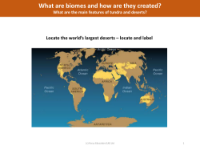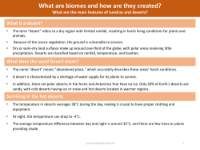What are the main features of the tundra and deserts? - Teacher notes

The tundra and deserts are two contrasting biomes, each with distinct characteristics shaped by their unique environmental conditions. Tundras are typically found in the high latitudes of the Arctic and Antarctic regions, as well as at high altitudes where alpine tundra exists. These areas are known for their cold climates, with temperatures often below freezing, which results in a landscape with a permanently frozen subsoil called permafrost. Vegetation in tundras is sparse and consists mainly of low-growing plants like mosses, lichens, and small shrubs. The tundra's biodiversity is limited due to the harsh climate, but it is home to specialised species that can withstand the extreme conditions.
Deserts, on the other hand, are defined by their arid conditions, receiving very little precipitation throughout the year. This scarcity of water results in a landscape that can be either sandy or rocky, with a limited variety of plant and animal life adapted to survive in such a dry environment. Deserts can experience extreme temperature variations, with very hot days and significantly cooler nights. Despite the challenging conditions, deserts are home to a range of resilient flora and fauna, including cacti and succulents that have adapted to conserve water, as well as animals with nocturnal habits to avoid daytime heat. Understanding the main features of tundras and deserts helps pupils recognise the significant differences between these two biomes, from the climate and soil to the types of organisms that inhabit them.







